Introduction
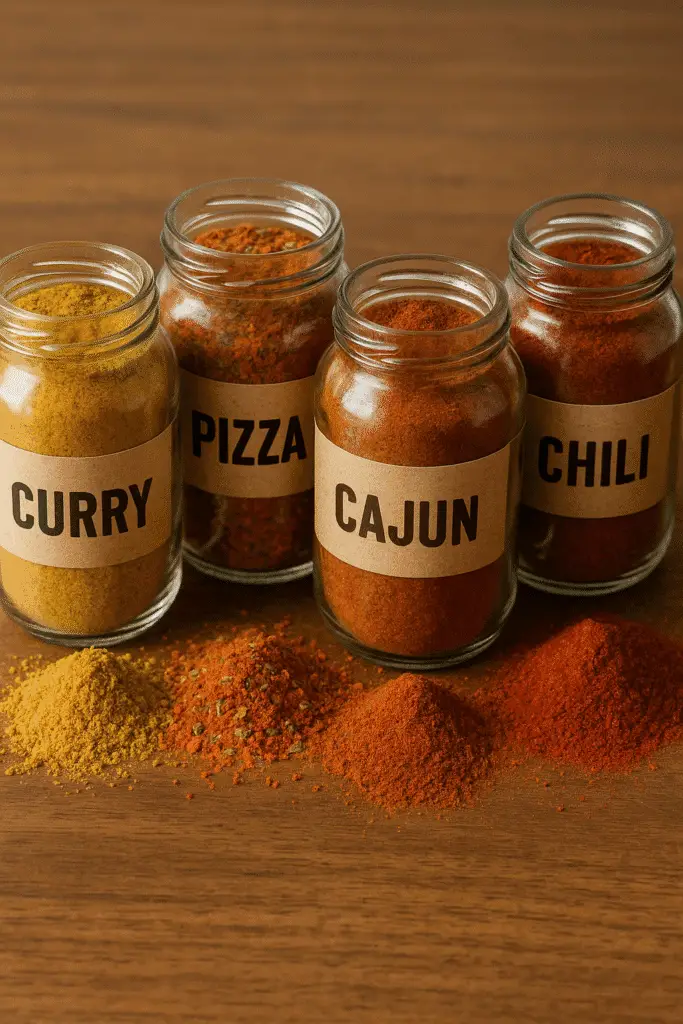
In the symphony of cooking, spices are the maestros, conducting a complex orchestra of flavors, aromas, and colors that transform simple ingredients into culinary masterpieces. From the vibrant markets of Marrakech to the bustling kitchens of Naples, spice blends are the unsung heroes, embodying centuries of tradition, regional influences, and the sheer joy of delicious food. They are more than just powders in a jar; they are passports to global cuisines, shortcuts to gourmet meals, and the secret weapon of every home cook.
In a world that constantly craves convenience without sacrificing quality, pre-mixed spice blends have become indispensable. They offer a harmonious balance crafted by experts, saving us the time and effort of sourcing and grinding individual spices. But what truly makes these blends special? What stories do they tell, and what culinary adventures do they unlock?
Today, we’re going on a deep dive into five iconic spice mixes, inspired by the essential blends found in many kitchens. We’ll explore their individual components, delve into their fascinating histories, uncover their unique flavor profiles, and provide you with inspiration to unleash their full potential in your own cooking. Get ready to embark on a flavorful journey that will elevate your dishes and enrich your understanding of the incredible power of spices. Our adventure begins with a blend that evokes the warmth and mystique of the East: the captivating Curry Spice Mix.
Part 1: The Golden Hues of the East – Deconstructing the Curry Spice Mix
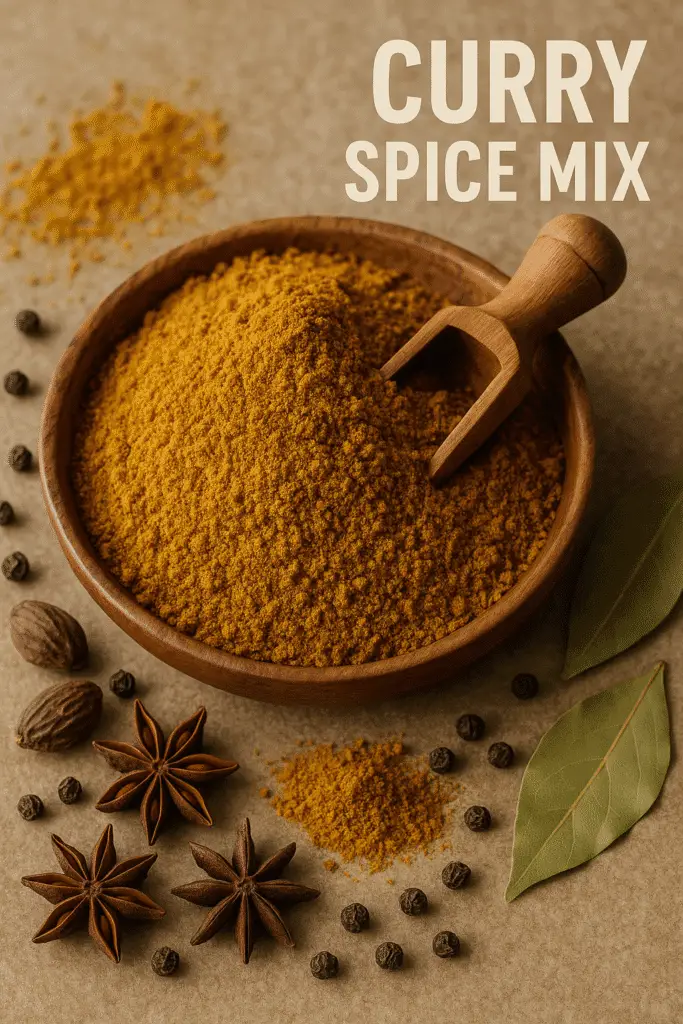
The very word “curry” conjures images of rich, aromatic stews, vibrant colors, and an undeniable warmth that comforts the soul. While “curry” as a singular dish is largely a British colonial term applied broadly to various South Asian stews, the Curry Spice Mix itself is a masterclass in blending, designed to bring the essence of these complex flavors to your kitchen with ease. It’s a fundamental blend that has transcended geographical boundaries, becoming a staple in kitchens worldwide.
The Anatomy of Our Curry Blend: According to our essential pantry guide, this specific Curry Spice Mix typically features:
- Coriander
- Cumin
- Turmeric
- Ginger
- Mustard Powder
Let’s break down how each of these components contributes to the blend’s signature profile:
Coriander (Coriandrum sativum): The Citrusy Backbone Often used in both its seed and fresh leaf (cilantro) forms, coriander seeds offer a surprisingly different profile. When ground, they release a delicate, almost citrusy sweetness with warm, nutty undertones. It’s a gentle spice, acting as a crucial base that rounds out sharper flavors and provides a fragrant, almost floral lift to the overall mix. Without coriander, a curry blend would feel less nuanced, lacking its characteristic bright foundation.
Cumin (Cuminum cyminum): The Earthy Depth If coriander is the bright beginning, cumin is the earthy soul of the blend. Its distinct, pungent, and warm aroma is unmistakable. Cumin brings a slightly smoky, hearty depth that grounds the other flavors, giving the curry its signature robustness. It’s a powerful spice, and a little goes a long way in imparting that quintessential “curry” aroma. Both whole seeds, toasted and ground, or pre-ground cumin are potent contributors to any authentic blend.
Turmeric (Curcuma longa): The Golden Heart and Soul Perhaps the most visually striking component, turmeric is responsible for the vibrant golden-yellow hue synonymous with many curry dishes. Beyond its stunning color, turmeric offers a warm, slightly bitter, and earthy flavor. It’s not just about aesthetics and taste; turmeric is also revered for its potent anti-inflammatory properties and health benefits, making it a superstar spice both culinarily and medicinally. It acts as a primary color and flavor agent, subtly binding the other spices together.
Ginger (Zingiber officinale): The Pungent Kick While fresh ginger root is a cornerstone in many South Asian dishes, dried, ground ginger powder provides a concentrated, pungent, and slightly peppery heat to the blend. It introduces a sharp, zesty warmth that cuts through richness and adds a layer of invigorating spice. It’s less about raw heat and more about a sustained, aromatic warmth that lingers on the palate.
Mustard Powder (Brassica juncea): The Subtle Tang and Bite A less obvious but equally important player, mustard powder adds a unique pungency and a slight, intriguing tang. It contributes a savory depth and a subtle, sharp bite that brightens the overall blend and prevents it from becoming one-dimensional. Depending on the type of mustard seed used, it can lend anything from a gentle warmth to a more pronounced, sinus-clearing piquancy.
The Art of the Blend: History and Culinary Impact The concept of a “curry powder” originated in India as a masala, which simply means a mixture of spices. However, the pre-mixed, shelf-stable “curry powder” as we know it today was largely popularized by British colonials returning from India, seeking to recreate the exotic flavors they had encountered. While authentic Indian cooking often involves freshly roasting and grinding individual spices for each dish, these ready-made blends offered a convenient way to capture some of that magic.
The brilliance of a well-balanced Curry Spice Mix lies in its versatility. It can be the foundation for:
- Classic Curries: Combine with coconut milk, tomatoes, or yogurt for rich stews with chicken, lamb, vegetables, or lentils.
- Marinades: Rub onto meats or vegetables before grilling, roasting, or pan-frying for an aromatic crust.
- Flavor Boosts: Stir into soups, rice dishes (like biryani or pilaf), or even scrambled eggs for an unexpected twist.
- Roasted Vegetables: Toss root vegetables or cauliflower florets with oil and curry powder before roasting for a vibrant, flavorful side.
The Curry Spice Mix is more than just a seasoning; it’s a testament to the power of blending, a shortcut to deep, complex flavors, and an invitation to explore the vast and delicious world of South Asian-inspired cuisine. Its golden promise of warmth and aroma is just the beginning of our spice journey.
Part 2: The Taste of Tuscany and Tradition – Discovering the Pizza Spice Mix
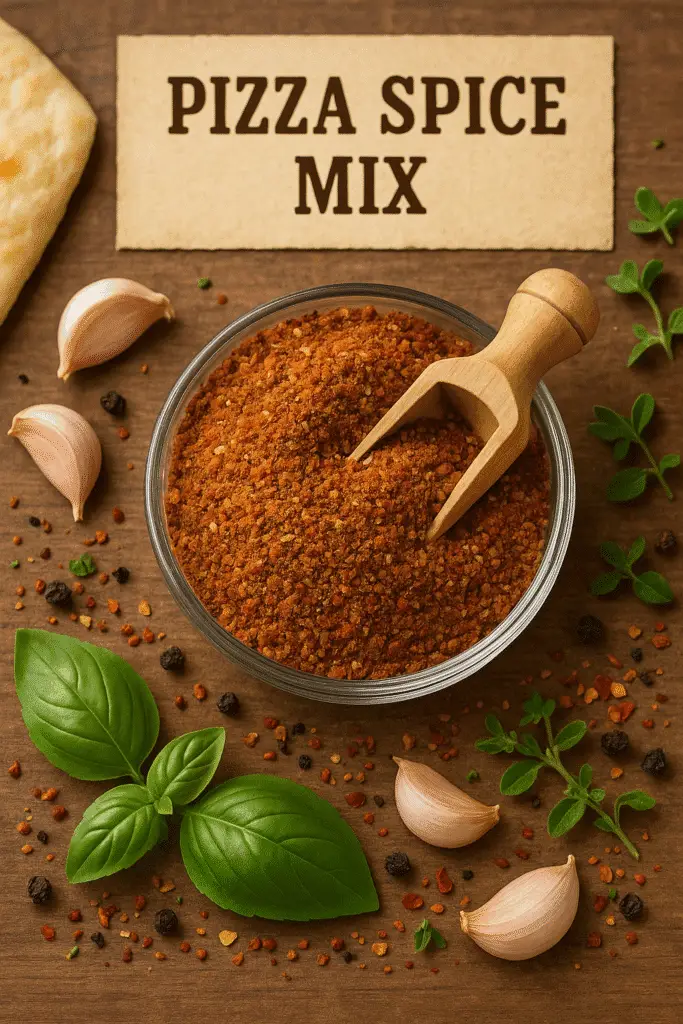
The Pizza Spice Mix is a global superstar. Unlike the Curry blend, which aims for deep, layered complexity, the Pizza mix is all about immediate recognition and robust, sun-drenched Italian flavors. It doesn’t just season pizza; it transports you to a rustic Italian trattoria where aromatic herbs are the heart of the kitchen. This blend is simple, direct, and essential for capturing that comforting, savory, and slightly piquant taste of classic Italian-American cuisine.
The Ingredients of Italian Comfort: The typical components found in this blend, as illustrated, are:
- Dried Oregano
- Dried Basil
- Dried Marjoram
- Dried Rosemary
- Garlic Powder
This blend is a powerful demonstration of how dried herbs, when properly combined, can create a flavor profile far greater than the sum of its parts. Let’s explore the contribution of these aromatic heroes:
Dried Oregano (Origanum vulgare): The Pungent Pioneer Oregano is arguably the most dominant flavor in any pizza mix. It is assertive, slightly peppery, and intensely aromatic. Its flavor is bold and slightly bitter, standing up wonderfully to rich tomato sauce, creamy mozzarella, and salty meats. In fact, many people associate the “pizza flavor” primarily with dried oregano. This herb’s powerful oil content means its flavor intensifies when dried, making it perfect for slow-cooked sauces and baking.
Dried Basil (Ocimum basilicum): The Sweet and Peppery Counterpoint While fresh basil is delicate and bright, the dried version is slightly more subdued but offers a crucial element: a sweet, slightly peppery, and anise-like aroma. Basil provides the high notes to Oregano’s bass, adding a necessary freshness and complexity. It’s the essential partner to tomato, creating the foundational flavor profile of countless Italian sauces, from classic marinara to pesto.
Dried Marjoram (Origanum majorana): The Gentle Cousin Often mistaken for oregano, marjoram is its sweeter, gentler cousin. While they are related, marjoram is milder and slightly floral, lacking the strong, pungent bite of oregano. Including marjoram in a pizza blend is a mark of quality, as it adds depth and softens the overall blend, weaving the stronger flavors together into a more harmonious tapestry. It introduces a subtle, sweet perfume to the finished dish.
Dried Rosemary (Salvia rosmarinus): The Piney, Resinous Note Rosemary brings a completely different textural and flavor element—a distinct piney, resinous, and somewhat savory taste. Because it is a more robust herb, it retains its structure and powerful flavor even when dried and cooked. Its presence adds a rustic, almost woody undertone, reminiscent of a wood-fired oven and often associated with regional Italian breads like focaccia. It pairs especially well with roasted ingredients and red meats.
Garlic Powder (Allium sativum): The Aromatic Amplifier Garlic is non-negotiable in Italian cooking. Garlic powder, as opposed to fresh garlic, offers a concentrated, savory, and slightly sweeter garlic flavor that disperses evenly throughout a dry rub or herb mix. It’s an immediate umami booster, providing a powerful, aromatic kick that elevates the savory notes of the herbs and acts as a universal flavor amplifier for meats, vegetables, and the crust itself.
The Culinary Versatility of the Italian Blend While its namesake is pizza, this mix is simply a classic Italian Seasoning, making its utility far-reaching:
- Sauces and Soups: It is the quick-fix flavoring for any tomato sauce, vegetable soup (like minestrone), or beef stew, infusing them with instant Mediterranean warmth.
- Breads and Doughs: Sprinkle over focaccia dough or mix into bread dough before baking. A simple olive oil dip can be transformed into a gourmet appetizer by stirring in a tablespoon of this blend.
- Meat Rubs: Mix with olive oil for a quick marinade for chicken, pork tenderloin, or fish. It’s particularly excellent for seasoning meatballs or Italian sausage.
- Vinaigrettes and Dressings: Whisk into red wine vinegar and olive oil for a vibrant and aromatic homemade salad dressing.
- Savory Popcorn: Toss freshly popped popcorn with butter, Parmesan cheese, and a generous shake of the Pizza Spice Mix for an addictive snack.
The Pizza Spice Mix is a powerful testament to the simple elegance of Mediterranean herbs. It represents the bright, clean, and savory flavors that define a large segment of comfort food globally.
Part 3: Fire and Funk on the Bayou – Exploring the Cajun Spice Mix
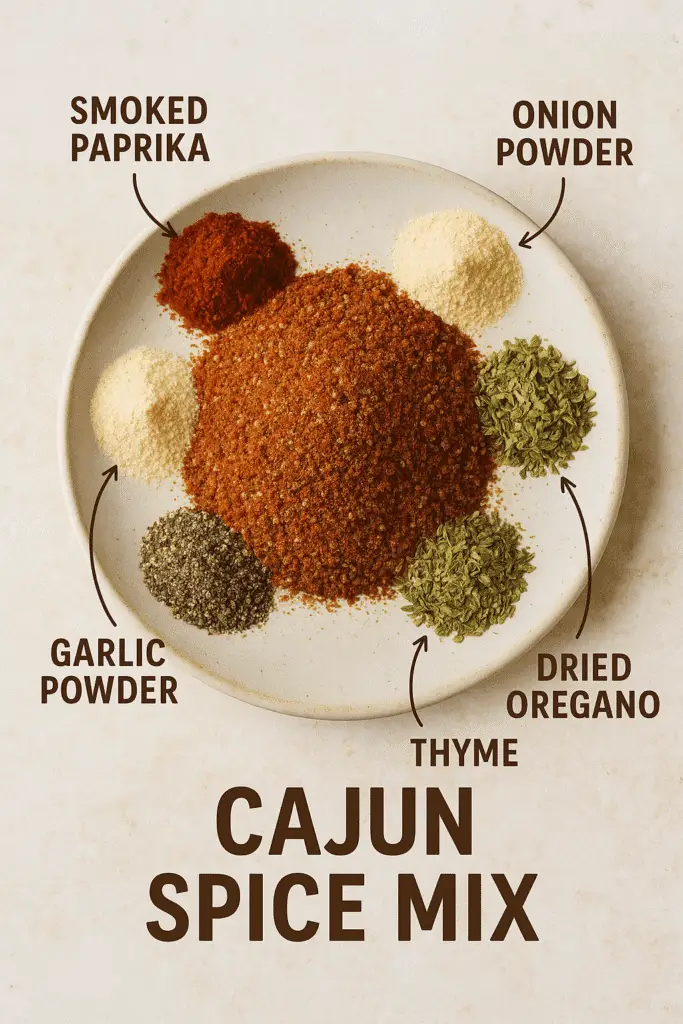
Where the Curry blend is about warmth and the Pizza mix is about herbaceous brightness, the Cajun Spice Mix is about flavor intensity, pungency, and a measured, earthy heat. This blend is the heart and soul of Cajun and Creole cuisine, rooted deeply in the unique history and geography of the Louisiana bayou. The flavor profile is characterized by a “holy trinity” of savory, pungent ingredients, balanced by classic herbs and a definitive kick of pepper.
The history of this blend is a fascinating fusion: it was created by the Acadians (French colonists expelled from Canada who settled in Louisiana) mixing their French culinary traditions with Spanish, West African, and Native American ingredients and techniques. The resulting cuisine, and the spice blend that defines it, is uniquely American and undeniably delicious.
The Intensity of the Cajun Blend: The components of our Cajun Spice Mix, as outlined in the image, are a study in contrast and balance:
- Paprika
- Onion Powder
- Garlic Powder
- Thyme
- Oregano
- Cayenne Pepper
Let’s dissect this powerful combination, understanding how each element contributes to the Cajun signature:
Paprika (Capsicum annuum): The Smoky, Sweet Foundation Paprika serves as the visual and textural base of the Cajun blend, giving it its appealing reddish-orange hue. Its role is twofold: it provides a mild, fruity sweetness and a subtle earthiness that prevents the blend from being purely savory or spicy. Whether sweet, hot, or smoked, paprika adds a necessary depth and richness, ensuring the heat is well-grounded in flavor.
Onion Powder and Garlic Powder (Allium spp.): The Holy Trinity’s Pungency If Cajun cuisine has a “holy trinity” of fresh ingredients (onion, celery, and bell pepper), then these two powdered giants are the “dry trinity” of the spice mix.
- Garlic Powder provides that essential, robust, savory aroma that is non-negotiable in Cajun cooking, serving as an instant flavor bomb.
- Onion Powder adds a necessary sweetness and an underlying, complex savoriness that complements the garlic.
Together, these two alliums provide the bulk of the deep, savory flavor, ensuring the blend works perfectly as a rub for meats or a starter for a roux.
Thyme (Thymus vulgaris): The Earthy, Piney Herb Thyme is the leading herbal note in a traditional Cajun blend. It provides an earthy, slightly minty, and piney aroma that is more savory and less sweet than the herbs in the Italian mix. Its robust flavor holds up well to long cooking times, making it ideal for the slow simmering required for gumbos, jambalayas, and étouffées.
Oregano (Origanum vulgare): The Sharp, Pungent Edge While also present in the Pizza mix, oregano plays a different, more subdued role here. It contributes a sharp, peppery note that balances the earthiness of the thyme and the sweetness of the onion and paprika. It’s the pungent flourish that adds complexity and aromatic appeal.
Cayenne Pepper (Capsicum frutescens): The Defining Heat This is the component that defines Cajun flavor intensity. Cayenne pepper brings the signature, clean, fast-acting heat that cuts through the savory richness of the dish. Unlike some chili powders that offer slow, building heat, cayenne is immediate and bright. The amount used dictates the final “kick,” but its inclusion is non-negotiable for an authentic bayou experience. The heat is a crucial element that elevates the dish, rather than merely punishing the palate.
Beyond the Bottle: Using the Cajun Blend The Cajun Spice Mix is the perfect all-purpose seasoning for the bold cook:
- Blackening: The blend’s most famous application is in “blackening,” where a protein (usually fish or chicken) is heavily coated in the blend, cooked in a smoking-hot cast-iron skillet, forming a delicious, dark crust.
- Gumbo and Jambalaya: This mix is essential for seasoning the protein and base of the slow-cooked stews and rice dishes that are hallmarks of the region.
- Fries and Popcorn: Sprinkle generously over French fries, sweet potato wedges, or popcorn for a savory, spicy kick.
- Meat Rubs: Use as a dry rub for ribs, pork shoulder, or brisket before smoking or grilling. The combination of pungent spices and heat creates a magnificent crust.
The Cajun Spice Mix is a vibrant culinary narrative—a complex blend that speaks to the multicultural history of Louisiana. It’s an invitation to cook boldly, using powerful, balanced flavors that leave a lasting, satisfying impression.
Part 4: Sweet Smoke and Sizzling Crust – Mastering the BBQ Spice Mix
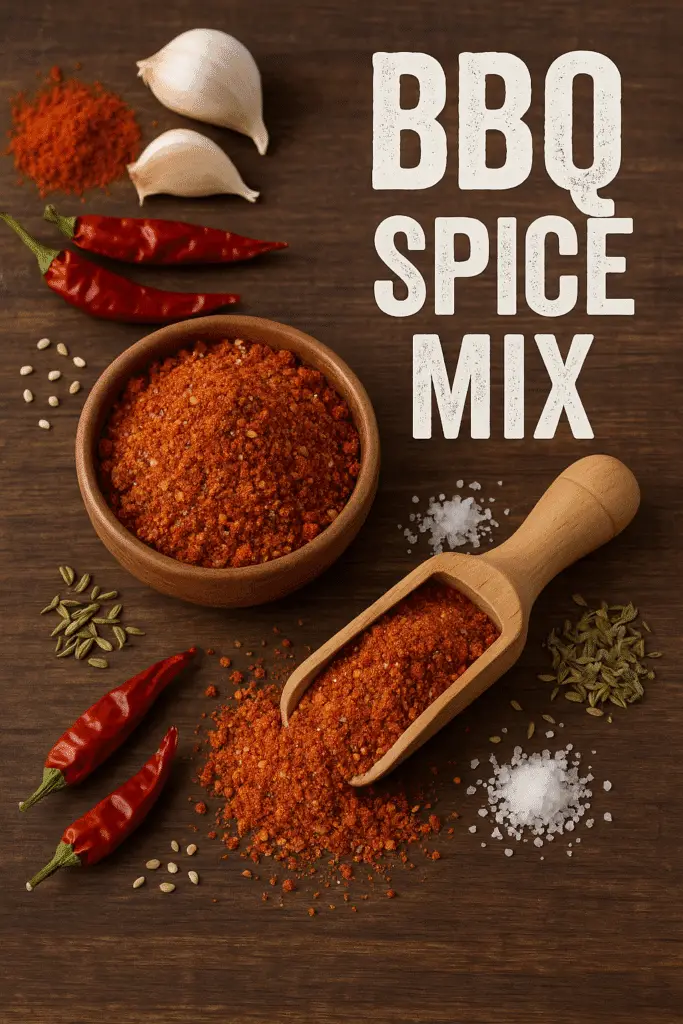
The BBQ Spice Mix, or dry rub, is fundamentally different from the previous blends because it prominently features an ingredient not typically found in the others: sugar. This blend is engineered for transformation—it’s designed to coat large cuts of meat, create a beautiful, caramelized crust (known as “bark”) when smoked or grilled, and balance deep, savory flavors with a touch of sweetness and heat. It is the epitome of American comfort cooking, varying wildly by region (Memphis sweet, Texas beefy, Carolina tangy), but always centered on a core philosophy of balance.
The Foundation of the Perfect Bark: The components of our essential BBQ Spice Mix reveal its balanced approach:
- Brown Sugar
- Chili Powder
- Dried Thyme
- Dried Rosemary
- Red Pepper Flakes
Let’s explore how this mix achieves its perfect harmony of sweet, smoky, and spicy:
Brown Sugar: The Caramelizing Catalyst Brown sugar is the defining characteristic of this blend. Its presence is vital not just for flavor, but for a crucial chemical reaction during cooking. As the meat cooks, the sugar melts and caramelizes, creating the deep, dark, flavorful crust, or “bark,” that is the hallmark of great barbecue. The molasses content in brown sugar adds a deep, rich, smoky sweetness that white sugar lacks, making the final flavor more complex and less cloying. It also helps tenderize the meat by drawing out moisture and creating a flavorful brine (when combined with salt, which is often added to this blend just before use).
Chili Powder: The Earthy Depth of Flavor Chili Powder serves as the main savory base, contributing a deep, earthy, and often slightly smoky flavor (especially if the paprika in the chili powder is smoked). A good commercial chili powder is often a blend itself—containing paprika, cumin, and oregano—giving the BBQ mix a robust, fundamental savoriness that prevents the sugar from dominating the profile. It provides a warm background heat that supports the other flavors.
Dried Thyme & Dried Rosemary: Aromatic Anchors While not as prominent as in the Cajun or Pizza mixes, these two robust herbs play a key role in adding complexity and freshness to the rich, savory meat.
- Dried Thyme maintains its earthy, slightly minty flavor through long cooking processes.
- Dried Rosemary contributes its distinct piney, resinous aroma.
Together, they cut through the richness of fatty cuts of meat like pork shoulder or brisket, lifting the flavor profile and adding an aromatic layer that suggests sophistication beneath the smoke.
Red Pepper Flakes: The Burst of Spot Heat Unlike the fine, even heat distribution of the ground cayenne in the Cajun blend, Red Pepper Flakes (often Capsicum annuum, primarily from the crushed seeds and pods of various peppers) provide a different kind of heat experience. They deliver pockets of concentrated heat that pop on the tongue, adding an unpredictable, bright, and slightly fruity dimension to the overall warmth. This uneven distribution of heat is part of the charm of a rustic BBQ rub.
The Culinary Science of the Rub A great BBQ rub is not merely seasoning; it’s a form of osmosis and caramelization. When applied liberally to meat hours or even days before cooking, the blend, especially the sugar and the accompanying salt, works to:
- Extract Moisture: Salt draws moisture out of the meat.
- Dissolve the Rub: The moisture dissolves the spices and sugar, creating a thin, flavorful paste or brine on the meat’s surface.
- Reabsorb Flavor: The meat then reabsorbs this hyper-flavored liquid, penetrating the surface layers with sweetness, heat, and savory spice.
- Form the Bark: When the meat is finally cooked at low temperatures (as in smoking) or high temperatures (as in grilling), the sugar-rich layer dehydrates and caramelizes, forming the iconic, delicious bark.
Beyond the Grill: While this mix shines on smoked ribs, brisket, and pulled pork, its sweet-and-savory balance makes it surprisingly versatile:
- Roasted Chicken: Use it as a dry rub for a whole chicken or chicken wings before roasting for a magnificent, crispy skin.
- Baked Beans: Stir a generous amount into baked beans or chili to add that essential sweet and smoky depth.
- Sweet Potato Fries: Toss sweet potato fries with a small amount of the blend before baking for a savory-sweet side dish.
- Popcorn: Combine with melted butter for a savory, smoky snack mix coating.
The BBQ Spice Mix is a symbol of American culinary passion, blending robust flavors and simple sugars to achieve a profound, complex, and utterly addictive result.
Part 5: The Hearty and Harmonious Bowl – Defining the Chili Spice Mix
The Chili Spice Mix is perhaps the most defining and hotly debated seasoning blend in American cuisine. At its core, chili is a culinary expression of warmth, comfort, and deep, slow-cooked flavor. Unlike the subtle nature of the Curry mix or the herbaceous brightness of the Pizza mix, the Chili blend is focused almost entirely on building a robust, savory, and satisfying profile centered around the capsicum family.
Chili powder, the main component, is itself an amalgamation of flavors, but the specific Chili Spice Mix is designed to be the complete seasoning package for a pot of chili, maximizing depth and richness.
The Power Trio of the Chili Blend: Our essential Chili Spice Mix consists of a few highly potent ingredients:
- Chili Powder
- Ground Cumin
- Paprika
- Garlic Powder
- Onion Powder
This lineup emphasizes savoriness and heat, demonstrating a laser focus on achieving a rich, dark, and complex finished product.
Chili Powder: The Concentrated Core The primary ingredient, Chili Powder, is the foundation of the blend. Importantly, “Chili Powder” (capitalized) is usually a pre-mixed product that provides flavor diversity and color, not just heat. A quality Chili Powder typically contains dried chili peppers (like ancho or New Mexico chilies), cumin, oregano, and sometimes garlic. Its role is to deliver a deep, dark, slightly fruity, and smoky note, providing the bulk of the characteristic “chili” flavor without overwhelming heat.
Ground Cumin: The Earthy, Smoky Signature Just as it was crucial in the Curry blend, cumin is utterly indispensable in a great Chili Spice Mix. It provides that unmistakable deep, earthy, and slightly smoky aroma that is immediately recognizable in a bowl of chili. Cumin pairs perfectly with the chili peppers and meat, adding a necessary layer of pungent warmth that differentiates chili from a simple stew.
Paprika: Color, Sweetness, and Texture Paprika, often confused with Chili Powder but milder, enhances the blend in several ways. It deepens the reddish color of the finished dish, adds a subtle sweetness to balance the heat, and, particularly if smoked paprika is used, contributes a layer of beautiful, wood-smoked flavor without requiring hours on a smoker. It rounds out the sharp edges of the ground chilies.
Garlic Powder and Onion Powder: The Savory Depth Charges Again, the powdered alliums are essential for instant depth. In a dish like chili, which is often cooked slowly, the powdered form ensures the pungent, savory flavor of onion and garlic penetrates every component of the pot. They provide the aromatic background that gives chili its “cooked-all-day” richness. They are the umami boosters that guarantee a satisfying, hearty flavor profile.
Achieving Chili Excellence: The Essential Steps Unlike the Pizza mix, which can be sprinkled cold, the Chili Spice Mix must be bloomed in hot fat—a technique common in South Asian cooking but essential here, too. To achieve maximum flavor:
- Sauté Aromatics: Cook your fresh onions and garlic first.
- Bloom the Spices: Before adding liquids, stir the entire Chili Spice Mix into the hot oil or rendered fat and cook it for 30 seconds to a minute. This process, called blooming or tempering, releases the oils in the dried spices, intensifying their flavor and aroma exponentially.
- Add Liquid: Then, and only then, add crushed tomatoes, broth, or water.
Versatility Beyond the Bowl: While it’s the king of chili, this savory blend has applications across the kitchen:
- Taco Seasoning: Add a pinch of sugar and cornstarch to the mix for a perfect homemade taco or burrito seasoning.
- Dips and Dressings: Stir into sour cream or Greek yogurt for a spicy, savory dip for vegetables or chips.
- Roast Rub: Rub onto pork tenderloin or chicken breasts before searing and roasting for a savory crust.
- Meatloaf: Incorporate a tablespoon into your meatloaf or hamburger patties for a smoky, spicy twist.
The Chili Spice Mix is the ultimate comfort blend, perfectly balancing the dark, fruity notes of dried peppers with the essential savory punch of garlic, onion, and cumin. It is the flavorful conclusion to our journey, proving that the most memorable dishes are often built upon the harmonious foundation of a perfectly crafted spice blend.
Conclusion: Your Pantry, Your Passport
Our journey through the Curry, Pizza, Cajun, BBQ, and Chili Spice Mixes has shown that a well-stocked spice rack is a library of global cuisines. Each jar is more than just a seasoning; it is a meticulously crafted balance of history, tradition, and culinary science.
- The Curry mix introduced us to the earthy complexity and ancient roots of Turmeric and Cumin.
- The Pizza mix reminded us of the bright, herbaceous simplicity of the Mediterranean, dominated by Oregano and Basil.
- The Cajun blend gave us a taste of the bayou’s fiery, pungent depth, powered by Cayenne and Thyme.
- The BBQ rub demonstrated the magic of caramelization, using Brown Sugar to balance smokiness and heat.
- Finally, the Chili mix brought us full circle, emphasizing the deep, savory comfort created by layering the bold flavors of the pepper and allium families.
The real power of these blends lies in their convenience and their ability to inspire. Don’t be afraid to use them as a starting point—tweak them with extra heat, add fresh herbs, or try them in unexpected recipes. Your spice rack is a pantry of possibilities. Go forth, experiment, and season boldly!







